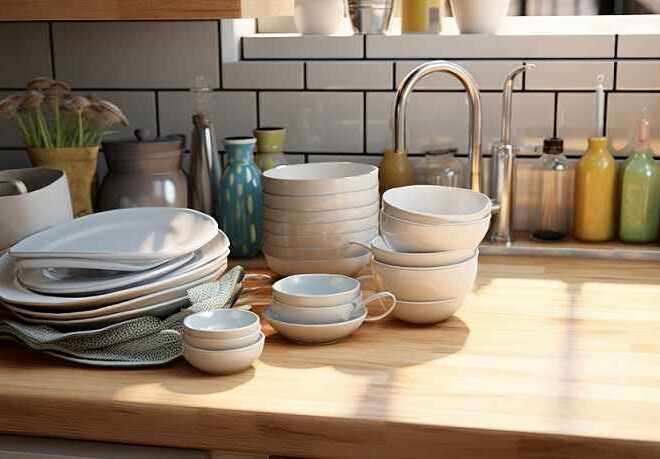
The Ultimate Guide to Cleaning Wooden Kitchen Cabinets: Tips and Tricks
Your kitchen is the heart of your home, where culinary magic happens and memories are made. But let’s face it—keeping those beautiful wooden cabinets looking pristine can sometimes feel like a daunting task. Whether you’re battling grease splatters from last night’s dinner or dust accumulation that seems to appear out of nowhere, cleaning wooden kitchen cabinets doesn’t have to be a chore. In this ultimate guide, we’ll unveil expert tips and tricks that will not only restore the shine and charm of your cabinetry but also make maintenance a breeze! Get ready to transform your kitchen into a space that sparkles with warmth and cleanliness, as we dive into tried-and-true techniques for caring for one of your home’s most valuable features. Say goodbye to dull surfaces and hello to stunning finishes—let’s roll up our sleeves and get started!
Introduction: The importance of keeping wooden kitchen cabinets clean
Wooden kitchen cabinets add warmth and character to any home. However, their beauty can quickly fade if they aren’t properly cared for. Grease, grime, and stains can build up over time, diminishing the charm of your cabinetry. Keeping them clean not only enhances their appearance but also extends their lifetime.
Imagine opening those cabinets to reveal a sparkling interior that reflects your commitment to cleanliness and style. In this guide, we’ll delve into essential tips and tricks for cleaning wooden kitchen cabinets effectively. Whether you’re facing greasy residues or pesky stains, we’ve got you covered! Let’s explore the best methods to restore your cabinet’s natural elegance without damaging the wood’s integrity.
Understanding the Types of Wood used for Kitchen Cabinets
When it comes to wooden kitchen cabinets, the type of wood plays a crucial role in both aesthetics and durability. Common choices include oak, maple, cherry, and hickory. Each type brings its own unique character.
Oak is known for its strength and distinctive grain patterns. It can add warmth to your kitchen while standing up against wear and tear.
Maple offers a sleek look with a fine texture that takes paint or stain beautifully. It’s less porous than other woods, making it resistant to moisture damage.
Cherry develops a rich patina over time, enhancing its beauty as it ages. This wood is perfect for creating an elegant atmosphere but requires gentle care.
Hickory stands out with its striking contrast between light and dark tones. Its toughness makes it ideal for busy kitchens where resilience is key. Understanding these variations helps you choose wisely when cleaning or maintaining your cabinets.
Preparing the Cleaning Solution: Natural vs Store-bought Products
When it comes to cleaning wooden kitchen cabinets, the choice of cleaning solution can make a significant difference. You have two main options: natural products or store-bought solutions. Each has its own advantages.
Natural cleaners often include ingredients like vinegar, baking soda, and lemon juice. They are eco-friendly and safe for your family. Plus, they effectively cut through grease without harsh chemicals.
On the other hand, store-bought products are designed specifically for wood surfaces. They may contain specialized formulas that promise quick results with minimal effort. Just be sure to check labels for any potentially harmful substances.
Consider what’s best for your home environment and personal preference when choosing between these options. Whether you opt for a homemade concoction or a commercial cleaner, both can help keep your cabinetry in tip-top shape if used correctly.
Step-by-step Guide to Deep Clean Wooden Cabinets
Start by emptying your cabinets. Remove all items, including dishes and utensils. This gives you a clear workspace and helps identify problem areas.
Next, dust the surfaces with a microfiber cloth to catch any loose particles. Pay attention to corners where dust tends to accumulate.
Prepare your cleaning solution. Mix warm water with a few drops of mild dish soap or use a natural vinegar-water blend for an eco-friendly alternative.
Dampen another clean cloth in the solution and wring it out well. Gently wipe down each cabinet door, working from top to bottom to prevent drips on already cleaned areas.
For tough grease buildup, apply baking soda directly on the stain and scrub gently with a soft-bristle brush or sponge. Rinse the area thoroughly afterward.
Finish by drying each surface with a dry cloth to avoid moisture damage, ensuring everything is spotless before replacing your items.
-
Removing Grease and Grime
Grease and grime can build up on wooden kitchen cabinets over time, especially around cooking areas. Tackling this mess requires a gentle touch to protect the wood’s finish.
Start by mixing warm water with a few drops of mild dish soap in a spray bottle. This natural solution is effective yet safe for your cabinets. Lightly mist the surface and let it sit for a minute to loosen sticky residue.
Using a soft cloth or sponge, wipe down the area in circular motions. Avoid abrasive scrubbers that could scratch the wood. Rinse your cloth frequently to prevent spreading grease around.
For tougher spots, consider adding white vinegar to your mixture. Vinegar cuts through grease effectively while being kind on surfaces. Just be sure to follow up with clean water afterward to remove any lingering acidity that may affect the finish over time.
-
Removing Stubborn Stains
Stubborn stains on wooden kitchen cabinets can be a real headache. These marks often come from spills, food splatters, or even greasy fingerprints that somehow become permanent residents.
For tougher stains, consider using vinegar diluted with water. Spray this solution onto the stain and wipe it away carefully with a microfiber cloth to avoid damage.
If all else fails, you might need a specialized wood cleaner designed for tough spots. Always test any product in an inconspicuous area first to ensure it doesn’t discolor your cabinets. Remember to follow up your cleaning efforts with some oil or polish to nourish the wood!
-
Polishing and Restoring Shine
Polishing wooden kitchen cabinets is essential for maintaining their beauty. A well-polished surface not only enhances the wood’s natural grain but also adds a protective layer.
Start by choosing a high-quality furniture polish that suits your cabinet’s finish. Look for products specifically designed for wood to avoid damaging the surface.
Apply the polish using a soft, lint-free cloth. Work in small sections to ensure even coverage and prevent streaks. Gently buff the area with circular motions, allowing the product to penetrate while bringing out that rich luster.
For extra shine, consider using beeswax or carnauba wax after polishing. These options provide additional protection against moisture and dirt without leaving residues.
Remember, less is more when it comes to product application; too much can lead to buildup and dullness over time. Regular polishing keeps your cabinets looking fresh and inviting!
Daily Maintenance Tips to Keep Your Cabinets Sparkling Clean
To keep your wooden kitchen cabinets looking pristine, daily maintenance is key. Start with a quick wipe-down using a soft, damp microfiber cloth. This simple habit helps remove dust and prevents build-up.
Pay attention to spills immediately. Wipe them up as soon as they happen. A gentle solution of warm water and mild dish soap works wonders for sticky spots.
Consider using a natural wood cleaner once in a while to enhance the shine without damaging the finish. Avoid harsh chemicals that can strip away oils and luster from the wood.
Also, be mindful of humidity levels in your kitchen. Excess moisture can warp or damage wooden surfaces over time. Using dehumidifiers may help maintain optimal conditions.
Finally, keep cabinet doors closed when not in use to minimize dust accumulation inside your cabinets while protecting their overall appearance.
Common Mistakes to Avoid When Cleaning Wooden Kitchen Cabinets
Cleaning wooden kitchen cabinets can seem straightforward, but common mistakes often lead to damage or ineffective cleaning. One major error is using abrasive cleaners. These can scratch and dull the wood’s finish, making your cabinets look worse.
Another pitfall is applying too much water while cleaning. Excess moisture can seep into seams and joints, causing warping or mold growth over time.
Using the wrong cloth poses problems as well. Harsh sponges or rags might leave lint behind or create scratches, diminishing the cabinet’s beauty.
Failing to test products on a hidden area is a mistake many make. Each wood type reacts differently; what works for one may ruin another.
Lastly, neglecting regular maintenance allows dirt buildup that becomes harder to remove later. Keeping up with simple daily routines prevents tougher cleans down the line and preserves your cabinets’ charm.
Alternative Methods for Tough Stains or Build-up
When traditional cleaning methods fall short, it’s time to explore alternative approaches for tough stains on your wooden kitchen cabinets. One effective technique involves using a mixture of baking soda and water. Produce a paste and gently apply it to the stained area. Let it sit for a few minutes before wiping away with a soft cloth.
Another option is white vinegar combined with olive oil. This natural result not only cleans but also nourishes the wood. Mix equal parts of both ingredients, apply them using a microfiber cloth, then buff the surface to reveal its shine.
For sticky residue or heavy build-up, try applying steam. A handheld steamer can help loosen grime without damaging the finish of your cabinets—just be sure not to overdo it! These methods provide an eco-friendly way to tackle even the most persistent issues while keeping your cabinetry looking fresh.
Conclusion: Final Thoughts and Recap
Keeping your wooden kitchen cabinets clean is essential for maintaining their beauty and longevity. A clean space not only looks good but also contributes to a healthier cooking environment. By understanding the types of wood used in your cabinets, you can choose the right cleaning methods that will protect them.
Preparing your cleaning solution is another critical step. Whether you opt for natural products or store-bought cleaners, knowing what’s safe and effective ensures your cabinets remain in top shape without damage.
The step-by-step guide provides simple yet effective techniques for deep cleaning. From removing grease to tackling stubborn stains, each method helps restore and maintain the original shine of your wooden cabinetry.
Daily maintenance tips are key to preventing build-up and keeping those surfaces sparkling day after day. Consistency is crucial in ensuring that dirt doesn’t become entrenched over time.
Avoiding common mistakes during the cleaning process can save you from unnecessary repairs or damages that might arise from improper care methods. With alternative approaches available for tough stains, there’s always a way out if things get tricky.
With these strategies at hand, you’re well-equipped to tackle any messes while enhancing the aesthetic appeal of your kitchen space—making it feel fresh and welcoming every day.


